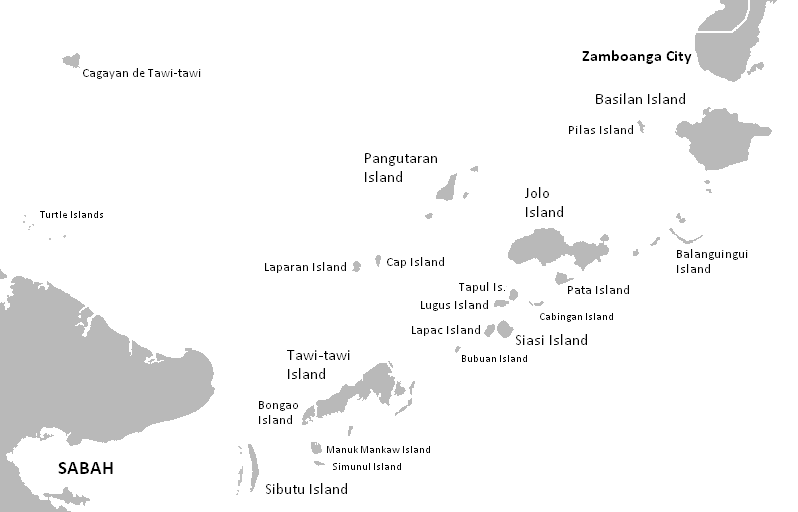|
Bantilan Muizzud-Din
Sultan Bantilan Muizzud-Din was the 20th Sultan of the Sulu Sultanate The Sultanate of Sulu (; ; ) is a Sunni Muslim subnational monarchy in the Republic of the Philippines that includes the Sulu Archipelago, coastal areas of Zamboanga City and certain portions of Palawan in today's Philippines. Historicall ..., reigning from 1748 to 1763. He was known as Datu or Pangiran Bantilan and was the younger brother of Sultan Azim ud-Din I. He is remembered for resisting foreign religious influence, strengthening Islamic governance in Sulu, and engaging in diplomatic treaties with European powers. Early life Sultan Bantilan was born in the Sulu Sultanate, the son of Sultan Badar ud-Din I and a princess from the Tidung Kingdom of northeastern Borneo. He belonged to the Maharajah Adinda branch of the royal family, recognized as the second heir-apparent in the line of succession.Royal Hashemite Sultanate of Sulu and North Borneo. ''Family History''. Retrieved from https://royalar ... [...More Info...] [...Related Items...] OR: [Wikipedia] [Google] [Baidu] |
Sulu Sultanate
The Sultanate of Sulu (; ; ) is a Sunni Muslim subnational monarchy in the Republic of the Philippines that includes the Sulu Archipelago, coastal areas of Zamboanga City and certain portions of Palawan in today's Philippines. Historically, the Sultanate included parts of present-day Sabah and North Kalimantan in north-eastern Borneo, but Malaysia does not recognize the territory of North Borneo as part of the Sultanate. The sultanate was founded either on 17 November 1405 or 1457 by Johore-born explorer and Sunni religious scholar Sharif ul-Hashim. ''Paduka Mahasari Maulana al Sultan Sharif ul-Hashim'' became his full regnal name; ''Sharif-ul Hashim'' is his abbreviated name. He settled in Buansa, Sulu. The sultanate gained its independence from the Bruneian Empire in 1578. At its peak, it stretched over the islands that bordered the western peninsula of Zamboanga in Mindanao in the east to Palawan in the north. It also covered areas in the northeast of Borneo, ... [...More Info...] [...Related Items...] OR: [Wikipedia] [Google] [Baidu] |
Sultans Of Sulu
This is a list of sultans of Sulu and later pretenders to the title. The Royal House of Sulu is a royal house of the Sulu Archipelago in the Philippines. Historically the head of the Sultanate of Sulu, after 1915 the position of sultan carries with it no political powers or privileges and became mostly a cultural figure. Pre-sultanate kings Sulu was divided into three kingdoms before the sultanate arose. The descendants of Paduka Pahala, through his two sons, live in Dezhou, China, and have the surnames An and Wen. Soon after, Sharif ul-Hāshim of Sulu arrived in Sulu and married the princess Dayang-dayang Paramisuli of the previous royal family, founding the Sultanate of Sulu. List of sultans Claimants after 1936 Any claimed political sovereignty of the sultanate was formally abolished in 1915, when Sultan Jamalul Kiram II renounced his remaining territories to the Insular Government. Its successor state, the Philippines, became a republic which repeatedly att ... [...More Info...] [...Related Items...] OR: [Wikipedia] [Google] [Baidu] |
18th-century Monarchs In Asia
The 18th century lasted from 1 January 1701 (represented by the Roman numerals MDCCI) to 31 December 1800 (MDCCC). During the 18th century, elements of Enlightenment thinking culminated in the Atlantic Revolutions. Revolutions began to challenge the legitimacy of monarchical and aristocratic power structures. The Industrial Revolution began mid-century, leading to radical changes in human society and the environment. The European colonization of the Americas and other parts of the world intensified and associated mass migrations of people grew in size as part of the Age of Sail. During the century, slave trading expanded across the shores of the Atlantic Ocean, while declining in Russia and China. Western historians have occasionally defined the 18th century otherwise for the purposes of their work. For example, the "short" 18th century may be defined as 1715–1789, denoting the period of time between the death of Louis XIV of France and the start of the French Revolution, ... [...More Info...] [...Related Items...] OR: [Wikipedia] [Google] [Baidu] |
Filipino Muslims
Islam in the Philippines is the second largest religion in the country, and the faith was the first-recorded Monotheism, monotheistic religion in the Philippines. Historically, Islam reached the Philippine archipelago in the 14th century, through contact with Muslim Malays (ethnic group), Malay and Arab merchants along Southeast Asian Trade, trade networks, in addition to Yemeni missionaries from the tribe of Alawites, Alawi of Yemen from the Persian Gulf, southern India, and their followers from several Sultan#Southeast & East Asia, sultanates in the wider Malay Archipelago. The first missionaries then followed in the late 14th and early 15th centuries. They facilitated the formation of sultanates and conquests in mainland Mindanao and Sulu Archipelago, Sulu. Those who converted to Islam came to be known as the Moro people, Moros, with Muslim conquest reaching as far as Kingdom of Tondo, Tondo that was later supplanted by Bruneian Sultanate (1368–1888), Bruneian Empire vassal ... [...More Info...] [...Related Items...] OR: [Wikipedia] [Google] [Baidu] |
Sunni Islam
Sunni Islam is the largest Islamic schools and branches, branch of Islam and the largest religious denomination in the world. It holds that Muhammad did not appoint any Succession to Muhammad, successor and that his closest companion Abu Bakr () rightfully succeeded him as the caliph of the Muslim community, being appointed at the meeting of Saqifa. This contrasts with the Succession of ʿAlī (Shia Islam), Shia view, which holds that Muhammad appointed Ali, Ali ibn Abi Talib () as his successor. Nevertheless, Sunnis revere Ali, along with Abu Bakr, Umar () and Uthman () as 'Rashidun, rightly-guided caliphs'. The term means those who observe the , the practices of Muhammad. The Quran, together with hadith (especially the Six Books) and (scholarly consensus), form the basis of all Fiqh, traditional jurisprudence within Sunni Islam. Sharia legal rulings are derived from these basic sources, in conjunction with Istislah, consideration of Maslaha, public welfare and Istihsan, jur ... [...More Info...] [...Related Items...] OR: [Wikipedia] [Google] [Baidu] |



